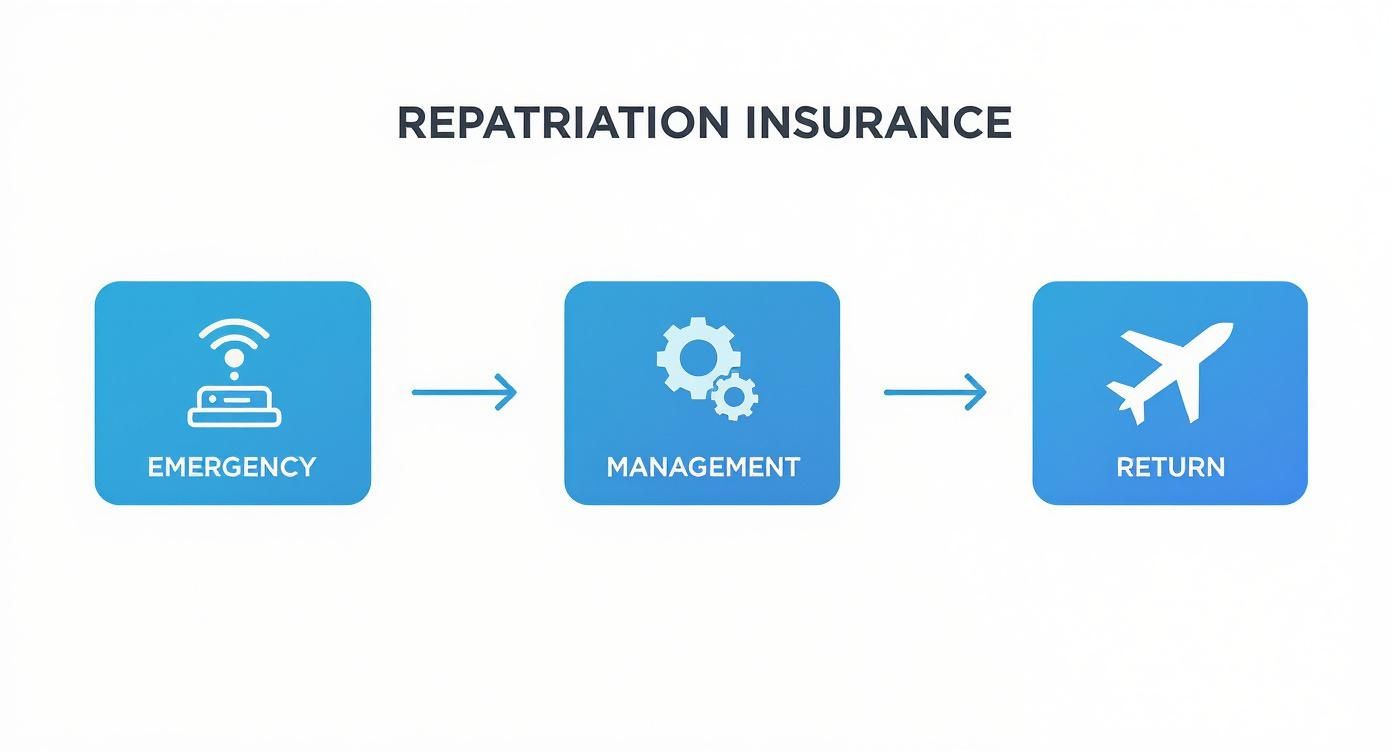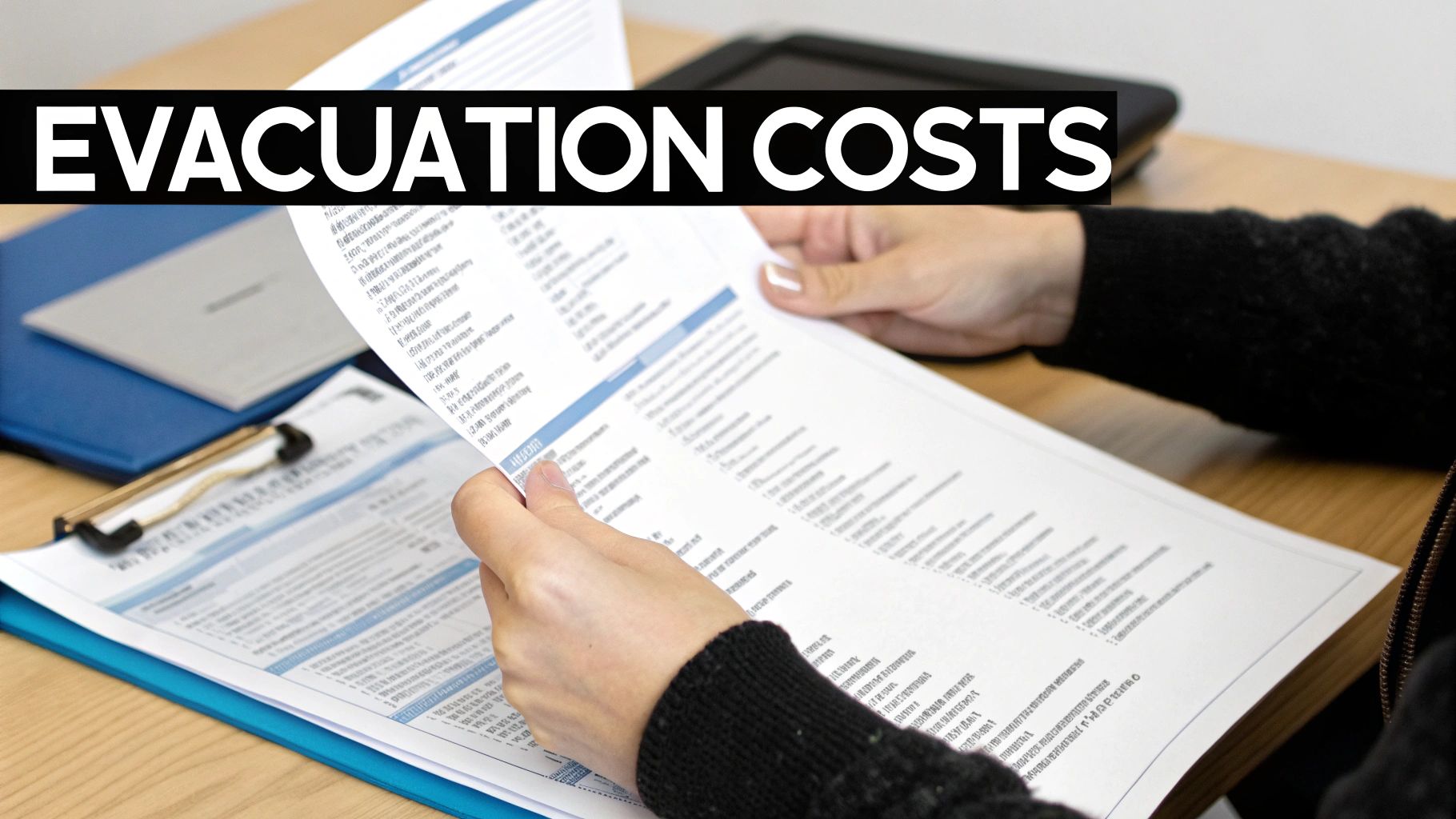Repatriation insurance is not merely another provision in a travel policy; it is your dedicated crisis management protocol for a serious medical event abroad. Consider it less an "insurance" product and more a sophisticated service designed to manage your health and well-being with precision.
Its sole purpose is to orchestrate and finance your transport to your home country once you are medically stable, or in the most unfortunate circumstances, to manage the dignified return of mortal remains.
The Core Function Of Repatriation Insurance
For any discerning international professional or expatriate, understanding what is repatriation insurance coverage is an absolute necessity. This is not about basic contingency planning; it is about safeguarding your health, preserving your financial portfolio, and securing your peace of mind.
A critical distinction must be made: standard international medical insurance covers your treatment costs in the foreign country. Repatriation coverage activates when local healthcare facilities do not meet requisite standards, or when a prolonged recovery is better managed in your home country, supported by your family and a familiar medical network.
This is a significant component of a comprehensive global strategy. The global medical repatriation service market, a key segment of this protection, was valued at approximately USD 1.5 billion in 2023. It is projected to reach USD 2.6 billion by 2032, signaling a clear trend: sophisticated global citizens are increasingly recognizing the indispensable nature of this protection.
Safeguarding Against Unforeseen Medical Crises
Imagine a severe accident or a sudden, life-threatening illness in a country where the medical infrastructure does not meet the standards you require. This is precisely the scenario where a repatriation policy becomes your most valuable asset, transferring the complex management of the situation to a team of dedicated experts.
This specialist team immediately assumes control, managing every critical detail on your behalf:
- Medical Coordination: They liaise directly with your treating physicians, obtaining a comprehensive clinical assessment to determine the safest and most effective method of transport.
- Logistical Management: They arrange all aspects of the transfer. This could involve a commercial flight accompanied by a medical professional or, in critical situations, a fully equipped private air ambulance.
- Financial Assurance: They cover the substantial costs associated with medical transport. The expense for an air ambulance can readily extend into six figures, a liability that would be financially detrimental for most individuals.
To articulate it simply, here is how the primary components function in concert.
Repatriation Insurance Core Components at a Glance
| Coverage Component | Primary Function | Typical Scenario |
|---|---|---|
| Medical Evacuation | Arranges and funds transport from an inadequate facility to the nearest appropriate medical center. | A severe injury in a remote location necessitates helicopter transport to a major metropolitan hospital. |
| Medical Repatriation | Organizes and pays for your transport back to your home country for ongoing medical care. | Following stabilization from major surgery abroad, you are flown to your home country for long-term recovery. |
| Repatriation of Remains | Manages the complex logistics and costs of returning mortal remains to the home country with dignity. | In the event of a death abroad, the policy handles all arrangements respectfully and efficiently. |
| 24/7 Assistance | Provides a dedicated team to coordinate all aspects of medical care, logistics, and communication. | A medical crisis occurs; you make a single call to an expert team that assumes complete management of the situation. |
This table demonstrates that repatriation insurance is far more than a simple financial indemnity; it is a comprehensive logistical and medical management solution.
In a moment of absolute crisis, repatriation insurance ensures your sole focus is on recovery. A dedicated team handles the immense, stressful, and costly complexity of orchestrating your safe return.
This level of protection is the foundation of any robust international health plan. To understand how it integrates into a broader strategy for global protection, review our complete guide on what to look for in an insurance cover. It is the ultimate assurance that regardless of where your professional or personal endeavors take you, a clear, fully funded, and expertly managed path home is secured.
How Repatriation Coverage Actually Works
When a serious medical emergency necessitates the use of your repatriation coverage, the policy transforms a chaotic event into a meticulously managed process. It commences with a single, decisive phone call.
The moment you, or an associate, contact your insurer's emergency assistance number, a global team of specialists is activated. This is not a standard call center; it is your logistical command post for the duration of the crisis.
Their initial action is crucial: they establish direct communication with the local physicians responsible for your care. They require a complete clinical assessment to understand your medical status and determine the precise requirements for a safe journey home. From this point forward, every decision is driven by medical necessity, with your well-being as the paramount priority.
The Coordination and Execution Phase
Once the medical facts are established, the assistance provider assumes full control, orchestrating the entire transport operation. This is a highly complex logistical undertaking.
Depending on your condition, they may dispatch a medical escort—a qualified physician or nurse—to accompany you on a commercial flight. In more critical circumstances, they will arrange for a private, fully equipped air ambulance to facilitate your return.
Behind the scenes, this team navigates the intricate web of international medical regulations, secures transfer clearances, and maintains constant communication between the medical facilities at both ends of the journey. The value of this expert management cannot be overstated; it alleviates an enormous burden from you and your family at a time of extreme vulnerability.
This infographic illustrates the typical process, from the initial emergency call to your safe return.

As you can see, it is a structured, professional response designed to manage every stage of the crisis with expertise.
The Financial Underpinning of Your Care
This entire operation is supported by significant financial resources. The global market for medical repatriation services was valued at approximately USD 1.5 billion in 2023, which underscores the capital required to execute these complex logistical movements worldwide.
This is a specialized segment of the much larger international private medical insurance industry. The scale of this market demonstrates the critical role that repatriation plays within the broader landscape of global protection. You can explore more about these market dynamics to appreciate the full scope of the industry.
In essence, repatriation coverage works by replacing uncertainty with a proven, systematic protocol. It ensures that when you are at your most vulnerable, an experienced team is making medically sound decisions, managing all logistical complexities, and providing the financial resources to bring you home safely.
What Your Repatriation Policy Should Cover

The specific provisions of your policy are paramount. A premier repatriation policy is substantially more than a mere travel ticket. For any high-net-worth individual operating globally, understanding the distinction between basic coverage and a genuine crisis management solution is key to true peace of mind.
The core of a superior policy is its capacity to handle high-acuity medical transport. This is not simply about returning you to your home country; it is about transferring you as a patient, with continuous, expert medical care throughout the entire journey.
A truly robust policy treats repatriation as a seamless hospital-to-hospital transfer that happens to cross international borders. Every detail is managed to ensure there is no interruption in medical supervision.
This elevated standard of care is built upon several non-negotiable features. When evaluating policies, these are the elements that distinguish exceptional plans from merely adequate ones.
Essential Medical Transport Inclusions
At its core, a high-quality policy must cover the most medically appropriate mode of transport, with all associated costs included. This is where the true value is realized, and it extends far beyond the price of a commercial flight.
Ensure the policy explicitly covers these critical services:
- Air Ambulance Services: This refers to a private, medically configured jet staffed by a dedicated medical team. It is the gold standard for transporting critically ill or unstable patients over long distances and is an absolute necessity in a premier policy.
- Medical Escort Provision: If your condition is serious but does not warrant an air ambulance, the policy should cover a physician or registered nurse to accompany you on a commercial flight, managing your care throughout the journey.
- Hospital Transfer Coordination: Coverage must encompass all ground ambulance fees and logistical coordination—from the originating hospital to the aircraft, and from the arrival airport to the destination hospital in your home country.
These three components form the backbone of proper repatriation coverage. However, the best plans incorporate an additional layer of support that addresses the human element of a medical crisis. You can see how these benefits integrate into a larger strategy by exploring the key international private medical insurance benefits uncovered in our detailed guide.
Ancillary Benefits for Complete Support
Beyond direct medical transport, elite policies include benefits that provide critical support to you and your family during an incredibly stressful period. These features demonstrate an insurer's commitment to holistic care.
Look for these key additional provisions:
- Compassionate Visit: If you are hospitalized abroad for an extended period, this covers the travel and accommodation costs for a close family member to join you.
- Return of Dependent Children: Should you become ill or injured while traveling with minor children, the policy should arrange and finance their safe, supervised return home.
- Repatriation of Remains: In the event of a fatality, a premium policy manages the significant financial and logistical challenge of returning mortal remains with dignity, handling all arrangements from legal documentation to transport.
By ensuring your policy includes these specific medical and personal support features, you are not just purchasing insurance—you are securing a comprehensive crisis management framework designed for any eventuality.
Understanding Policy Limits And Exclusions
To leverage your repatriation coverage effectively, you must understand its precise boundaries. A policy's true value is defined not only by what it covers, but also by its explicit exclusions. A thorough understanding of these details is the only way to ensure your policy performs as expected during a critical event.
Most policies are designed to respond to a single contingency: an unforeseen and acute medical emergency. Consequently, they draw a firm line around any situation that falls outside that specific scope. Knowing where those lines are drawn will prevent unwelcome surprises when you most need support.
The Standard of Medical Necessity
The single most important concept to comprehend is medical necessity. This is the criterion insurers use to determine if a repatriation is justified. Your personal desire to return home—while completely understandable—is not the trigger for coverage.
The decision to repatriate is a purely clinical determination made by the insurer's medical team in consultation with your local treating physicians. It is approved only when deemed medically essential for your health and recovery, not as a matter of personal preference.
This is a critical distinction. The medical directors will first assess whether the local facility can provide the appropriate standard of care. If it can, they will almost certainly recommend you remain there until stable enough for a standard commercial flight.
If local care is inadequate, they will initiate a transfer to the nearest appropriate facility. Note the precise wording. That facility may be in your home country, or it may be in a different country that is closer and better equipped for your specific medical needs.
Common Policy Exclusions to Be Aware Of
Every policy contains a list of exclusions. While the exact language varies between providers, certain exclusions are nearly universal. Being aware of them in advance allows you to ensure your activities and health profile align with your policy's protections.
Key exclusions to note include:
- Undeclared Pre-existing Conditions: This is the most common reason for claim complications. Failure to disclose a known medical condition during the application process can give the insurer grounds to void coverage for any related issue. Full transparency from the outset is non-negotiable.
- Elective or Experimental Treatments: Repatriation insurance is exclusively for emergencies. It will not cover transport for planned surgeries, cosmetic procedures, or any treatment not considered medically standard and proven.
- High-Risk Activities: If you participate in activities such as mountaineering, polo, or motorsports, you must scrutinize your policy. These are often excluded unless you have secured a specific add-on, or "rider," to provide coverage.
A firm grasp of these details is key to ensuring your policy is a reliable asset. You can learn more about medical conditions and policy exclusions for a deeper analysis of how insurers approach these critical points. A clear understanding of these boundaries ensures that if a crisis occurs, your only focus will be on your recovery.
The True Financial Risk Of An Uninsured Emergency

To view repatriation insurance as a simple travel expense is a fundamental and potentially catastrophic miscalculation. This is not a line-item cost; it is a sophisticated financial instrument designed to neutralize a risk substantial enough to jeopardize your entire financial future.
Without this coverage, you are personally liable for the full cost of an international medical evacuation. These costs are staggering.
Consider a serious medical event in South America requiring transport to a U.S. hospital. The cost for an air ambulance is not a minor expense—it can range from $50,000 to $100,000. Should that emergency occur in a more remote location, such as Southeast Asia, the cost for the same transport can easily exceed $200,000. These figures are for transport alone and do not include the fees for the onboard medical team, ground ambulances, or associated administrative charges.
An uninsured medical emergency abroad does not just disrupt your plans; it poses a direct threat to your financial portfolio. The six-figure cost of an air ambulance can liquidate assets that have taken years, or even decades, to accumulate.
The Value Proposition Of Coverage
When these six-figure potential liabilities are compared to the modest premium of a repatriation policy, the value proposition becomes exceptionally clear. The insurance premium effectively transfers this enormous potential debt for a predictable, manageable annual fee.
An unpredictable, financially ruinous event is thereby converted into a fixed, planned expense.
This is precisely why a clear understanding of what is repatriation insurance coverage is critical for wealth preservation. The market data corroborates this. The global travel insurance and assistance market was valued at USD 22.4 billion in 2023 and is projected to reach USD 54.7 billion by 2033. Many of these policies feature emergency evacuation benefits offering up to USD 1 million in coverage—a clear indicator of the severe financial fallout high-net-worth individuals seek to mitigate.
Let's examine a direct comparison.
Estimated Repatriation Costs vs. Insurance Premium
| Repatriation Scenario (Example) | Estimated Cost Without Insurance | Typical Annual Premium Range |
|---|---|---|
| Medical evacuation from Europe to the U.S. | $75,000 – $125,000 | $400 – $800 |
| Air ambulance from Southeast Asia to the U.S. | $200,000 – $250,000+ | $400 – $800 |
| Repatriation of remains from South America | $15,000 – $25,000 | $400 – $800 |
The data is unequivocal. You are trading a nominal annual sum to eliminate a potential quarter-million-dollar liability.
One insures a primary residence against fire, though the statistical probability is low. The potential financial devastation of an international medical emergency is equally real and often far more costly. The same logic applies to other overlooked areas, like the hidden costs of pet travel-don-t-realize-until-it-s-too-late), where a minor oversight can result in significant, unexpected expenses.
Repatriation insurance is your financial firewall. It ensures your assets remain protected and shields your family from the colossal costs of a medical crisis far from home.
How To Choose The Right Repatriation Policy
Selecting the appropriate repatriation policy requires more than a cursory review. You must look beyond marketing materials and analyze the critical components of the coverage. The objective is not merely to secure a financial safety net, but to retain a world-class crisis response team capable of executing a successful return under extreme pressure.
The true measure of a policy lies within its coverage limits. While many plans appear adequate initially, their benefits are often capped at insufficient levels. It is imperative to seek policies with exceptionally high or, ideally, unlimited coverage. A single international air ambulance flight can easily exceed $200,000, making a low benefit limit an unacceptable financial risk.
A repatriation policy is only as good as its 24/7 assistance provider. This is the entity on the other end of the line managing the entire crisis. Their experience, global infrastructure, and reputation are non-negotiable assets.
Evaluating The Assistance Provider
Set aside the policy document for a moment. The most critical component of your coverage is the assistance company that executes the plan. These are the professionals who coordinate with local physicians in a foreign language, arrange emergency transport, and navigate international bureaucracy on your behalf. Their real-world experience and global network are what transform a policy document into a life-saving resource.
When consulting with a broker or insurer, it is essential to ask probing questions to validate the quality of their crisis response capabilities:
- Global Network: "Describe your assistance provider's network. Do they have established, on-the-ground relationships with air ambulance services and hospitals worldwide, or are they simply a call-forwarding service?"
- Medical Team: "Who are the in-house medical directors who would manage my case? What are their credentials? Are they call center operators, or are they board-certified physicians who can consult peer-to-peer with my treating doctors?"
- Response Time: "Detail your operational process. From the moment an emergency call is placed, what is your average time to have a medical transport team airborne?"
Finally, obtain absolute clarity on how the policy addresses pre-existing conditions. The best policies utilize simple, unambiguous language. Ensure you know precisely how your medical history affects your coverage to eliminate any potential for disputes during a claim.
By focusing on these three pillars—coverage limits, provider reputation, and policy clarity—you can select a plan that delivers when it matters most.
A Few Common Questions About Repatriation
When delving into the specifics of international health plans, several key questions about repatriation consistently arise. Let's address the most common inquiries.
Is Repatriation The Same Thing As Medical Evacuation?
This is an excellent question, and the answer is no—though they are closely related, and a superior policy must cover both. The distinction is as follows:
Medical evacuation is the immediate emergency response. Its purpose is to transport you from a place of danger or an inadequate facility to the nearest capable hospital as quickly as possible, even if that hospital is in a neighboring country.
Repatriation, conversely, is the journey to your home country. It typically occurs only after you are medically stable enough to endure a long-distance flight. Its objective is to bring you back to your country of residence to continue your recovery or receive long-term care within a familiar medical system. A premier policy will not force a choice; it will provide for both scenarios as medically appropriate.
Does My Premium Credit Card Cover This?
Certain high-end credit cards offer a form of travel medical coverage, but it is rarely an adequate substitute for a dedicated international health policy. The coverage is almost always capped at much lower limits and is accompanied by extensive fine print and restrictive exclusions.
Relying solely on credit card benefits for a matter as serious as repatriation is a significant financial risk. These ancillary benefits are highly unlikely to cover the full, often six-figure cost of a private air ambulance. It is imperative to read the terms and conditions in detail—never gamble your financial well-being on a card benefit.
Who Actually Makes The Decision To Repatriate Me?
This is not a decision that you or your family can make independently; it is a purely clinical determination. The final authority rests with the insurance provider's medical team, who work in close consultation with the physicians treating you locally.
Two conditions must be met: you must be medically stable enough for the journey, and the transfer must be deemed medically necessary. The decision is based on established medical protocols designed to ensure your health and safety, not on personal preference. This framework guarantees a transfer only proceeds when it is verifiably safe and appropriate for your condition.
Navigating the complexities of international health insurance can be a formidable task. For expert, objective guidance in securing a plan with robust repatriation coverage, contact Riviera Expat. We bring clarity and confidence to your global healthcare strategy. https://riviera-expat.com

